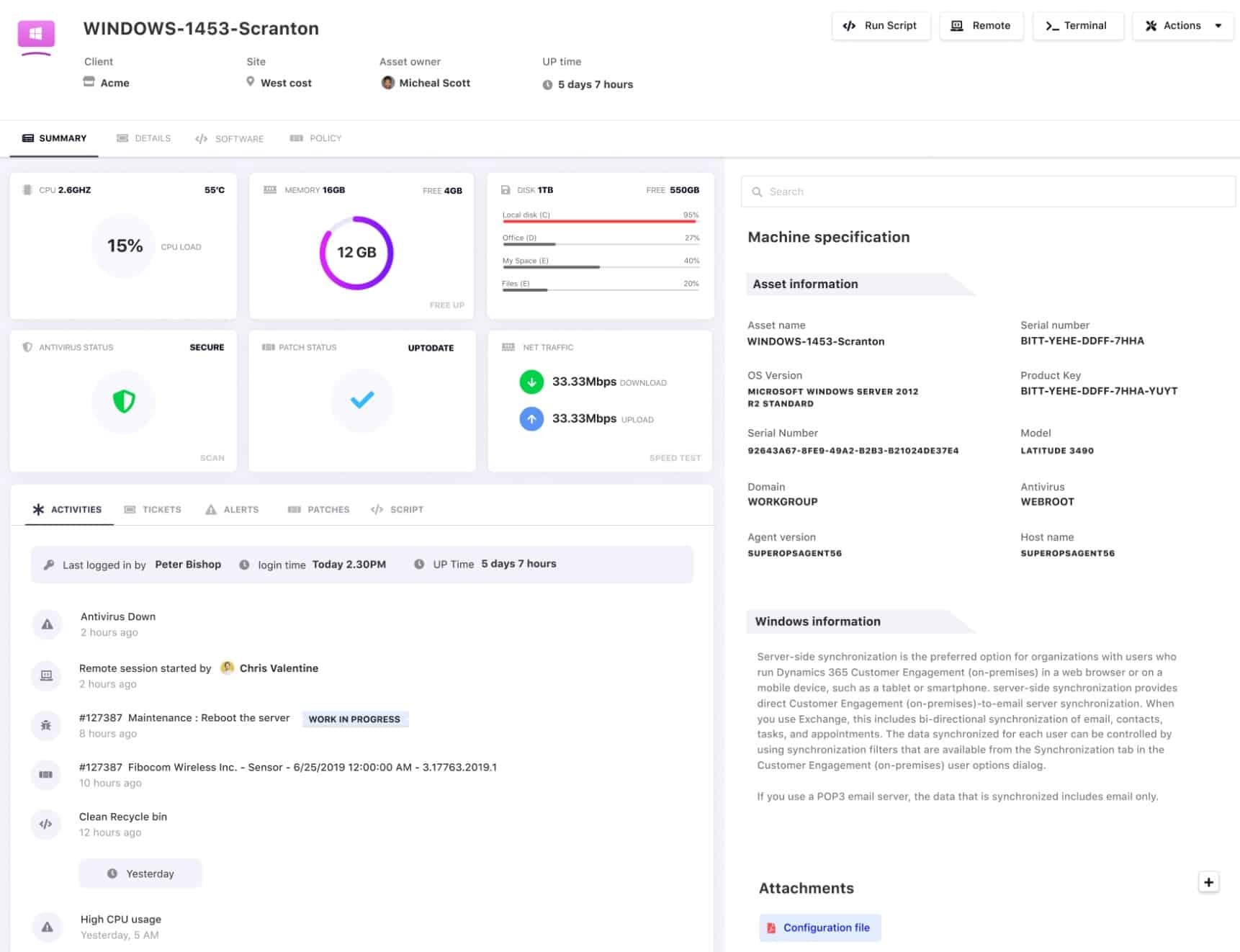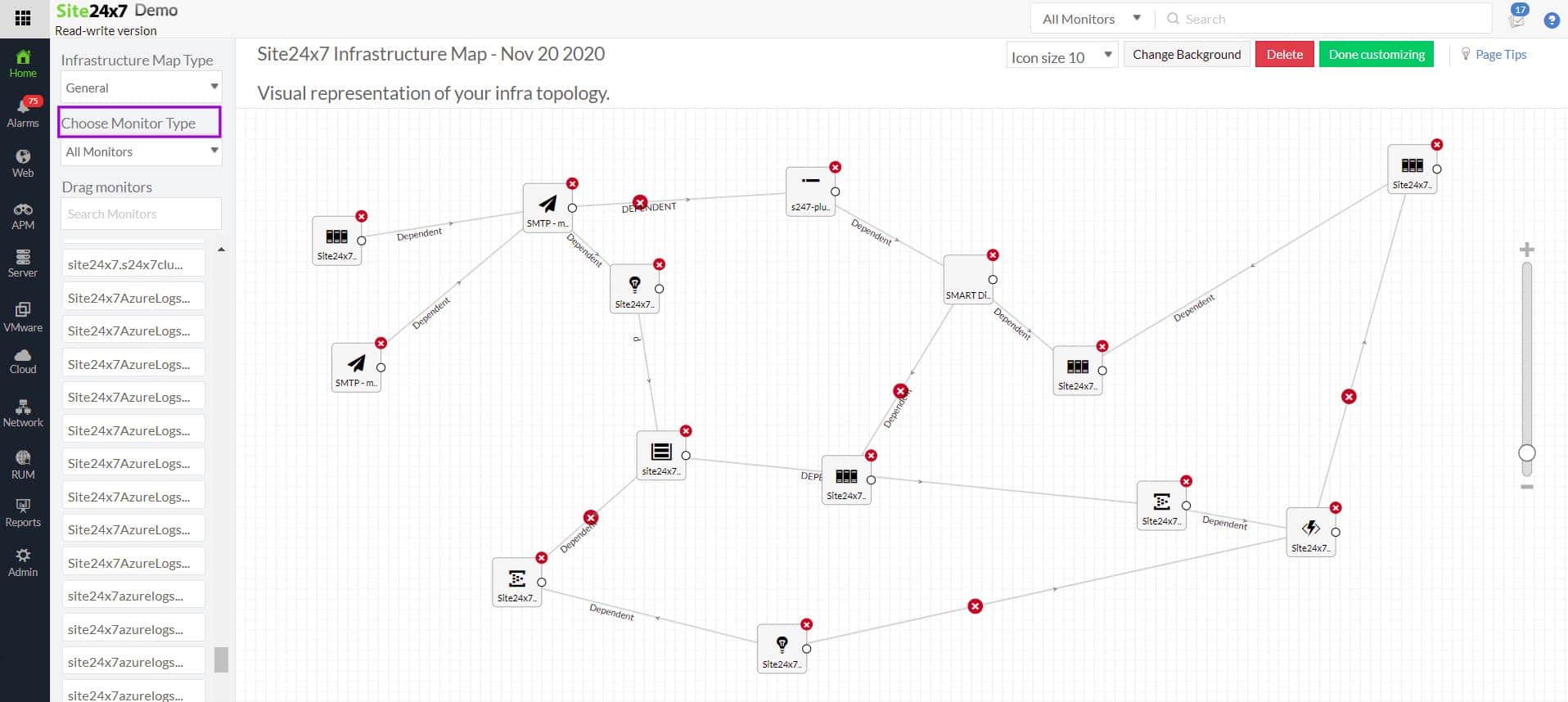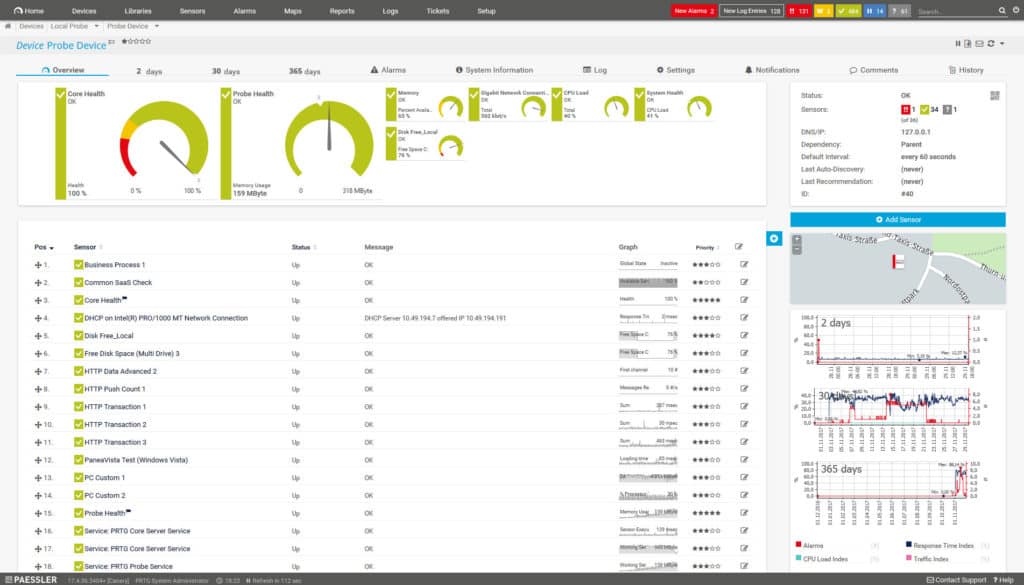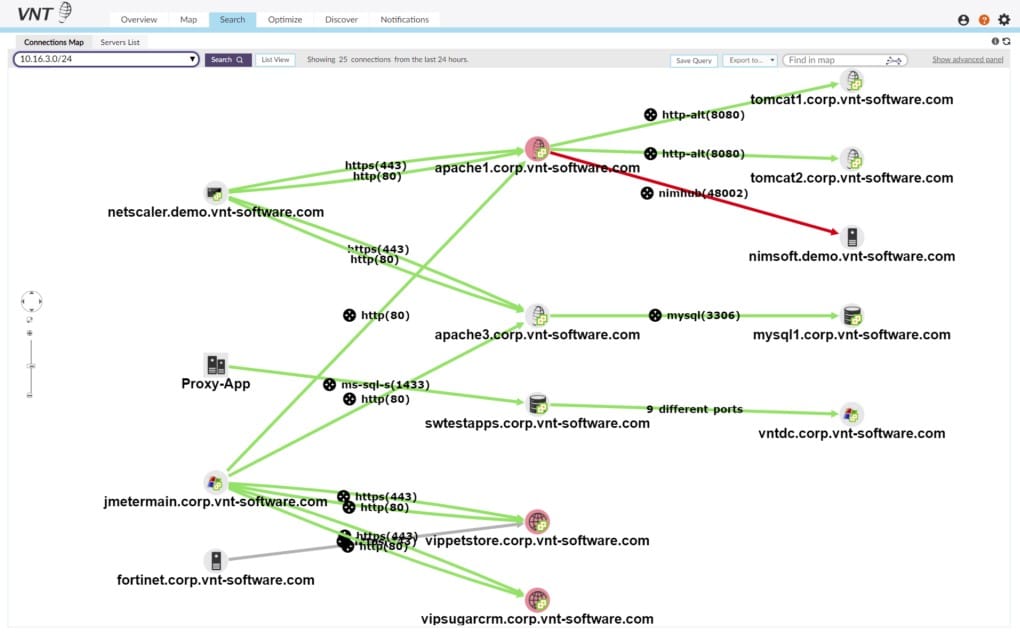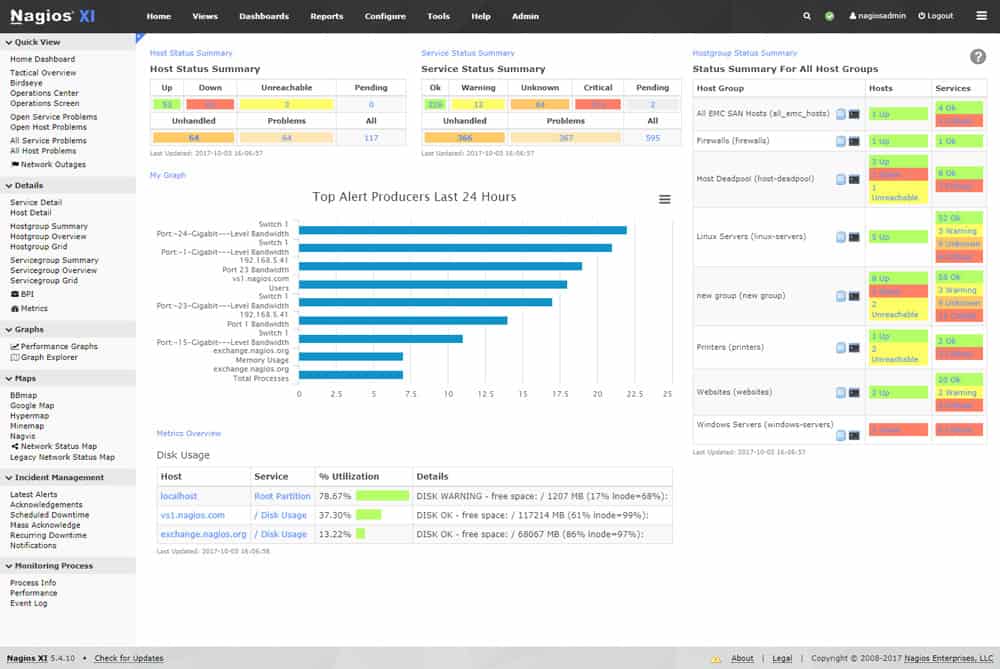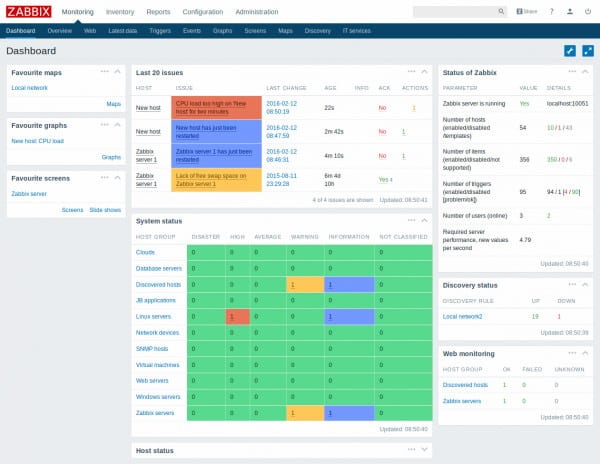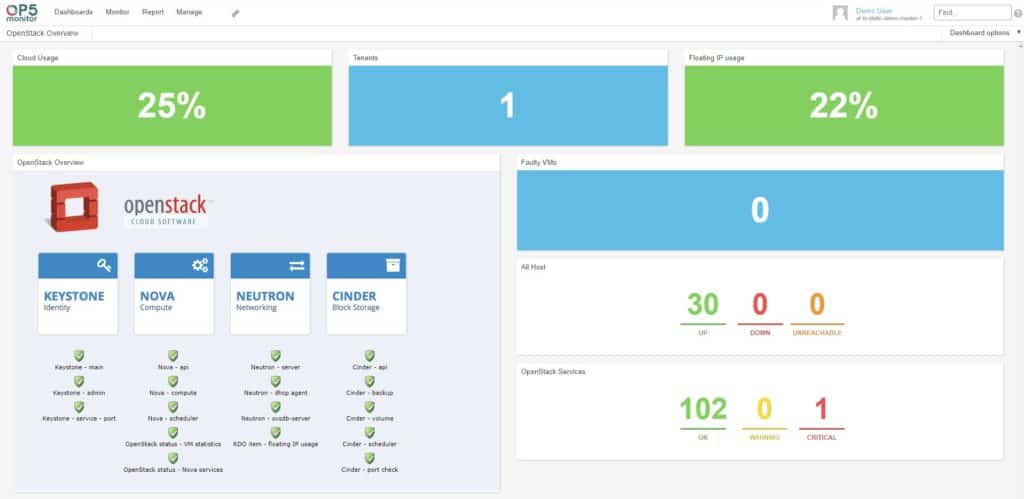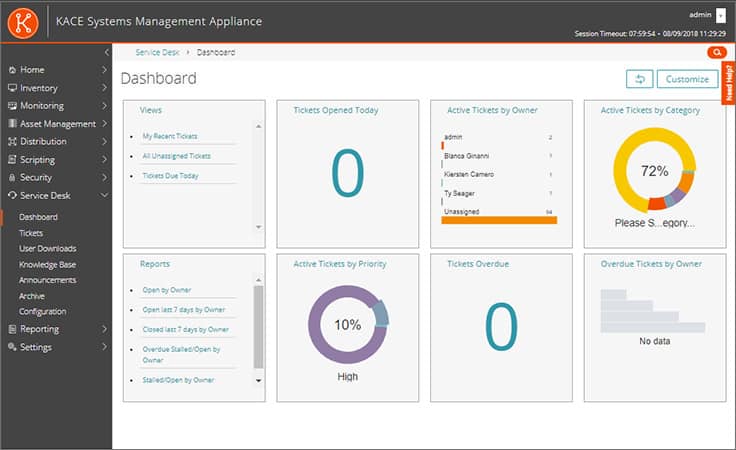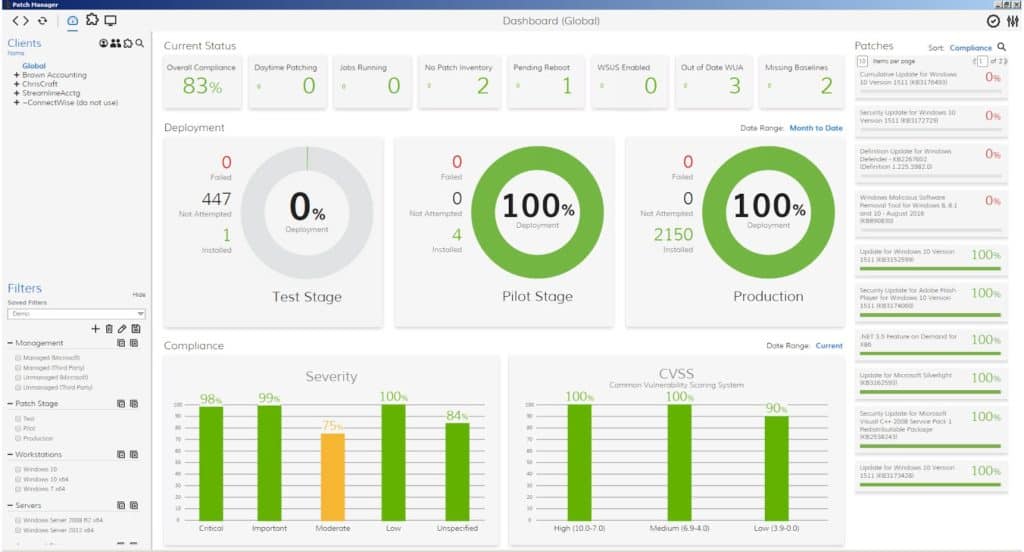Our growing digital ecosystem can quickly become unwieldy and create more problems than benefits. To avoid these negative issues, you need a top-notch systems management tool that can provide the visibility and control required over your different systems and platforms.
However, choosing a systems management tool is not easy, especially with vendors making bold claims about automation and security. We help you navigate through this maze with our insightful and hands-on testing. More importantly, we understand your pain points, as the tools discussed in this article address the following issues:
- Your IT teams struggle with monitoring and managing all endpoints efficiently.
- Routine tasks like patching, updates, and configuration take too much time.
- Ensuring devices meet security policies across hybrid environments is difficult.
- Growing IT infrastructure increases complexity, and a lack of centralized control opens blind spots.
- Without proactive monitoring, downtime and inefficiencies become costly.
A well-designed systems management solution addresses these challenges through features like automation, real-time monitoring, remote management, and security compliance
In this guide, we break down the top systems management tools, highlighting their strengths, best use cases, and key features to help you make an informed decision.
Here is our list of the best systems management tools and software:
- NinjaOne EDITOR’S CHOICE A remote monitoring and management system that automates many standard system management tasks. Suitable for centralized IT departments and managed service providers. Start a 14-day free trial.
- SuperOps RMM (FREE TRIAL) A cloud-based package of services that allows MSP technicians to manage the systems of their clients. Start a 14-day free trial.
- Site24x7 (FREE TRIAL) A cloud-based platform of system monitors that cover websites, applications, servers, and networks. Start a 30-day free trial.
- ManageEngine Endpoint Central (FREE TRIAL) A unified endpoint management solution for local or remote sites that includes regular maintenance routines and onboarding services. Available for Windows Server or as a cloud-based service. Start a 30-day free trial.
- Paessler PRTG Network Monitor (FREE TRIAL) A network monitoring tool with autodiscovery that can find devices and recommend appropriate sensors. Start a 30-day free trial.
- ManageEngine Applications Manager (FREE TRIAL) A monitoring system that tracks on-premises and cloud resources, following their performance and dependencies. Available for Windows Server and Linux. Start a 30-day free trial.
- Faddom This hybrid software package discovers all devices connected to a network and maps them. It also performs application dependency mapping and is able to monitor both networks and applications. Runs as a virtual appliance.
- Atera A cloud-based service that offers packages of technician tools for use by remote support teams that can be working for in-house IT departments or managed service providers. Bundles also include MSP management systems.
- N-able N-sight A remote monitoring and management tool that enables central IT departments to manage IT systems on remote sites.
- SolarWinds Systems Management Bundle A system monitoring bundle of four tools including a server monitoring tool, virtualization manager, storage resource monitor, and web performance monitor.
- Nagios XI Infrastructure monitoring tool with graphical displays, capacity planning capabilities, integrated APIs, and a community’s worth of add-ons.
- Zabbix Open-source system monitoring solution with out-of-the-box configurations for popular device vendors and network health/performance monitoring.
- OP5 Monitor Open source-network monitoring tool that can monitor SNMP devices, with configurable alerts and a reporting system.
- KACE Systems Management Appliance Systems management platform that can monitor devices, run vulnerability scans, deploy patches, and generate alerts.
- ConnectWise Automate Systems management tool with autodiscovery, automation, and virtual patching.
Key points to consider before purchasing a systems management tool
While selecting a systems management tool, start with a comprehensive understanding of your current IT environment and what problems you are looking to address with this tool. This approach can guide you in identifying the best fit for your organization.
- Breadth of System Coverage: Your selected solution must provide centralized visibility across all your critical IT assets.
- Real-Time Monitoring and Alerting: A good tool should offer continuous system health monitoring, proactive alerts for performance degradation, and predictive analytics to prevent failures before they occur.
- Patch and Update Management: Look for a tool that automates patch deployment, validates updates in a test environment, and ensures compliance with internal policies.
- Configuration Management: A strong tool will automate configuration enforcement, prevent unauthorized changes, and provide rollback options in case of failures.
- Remote Management and Troubleshooting: Your tool must diagnose and fix issues remotely, restart services, deploy software, and enforce policies without requiring physical access to machines, especially if you have hybrid and remote workforces.
- Resource Optimization and Performance Tuning: A good tool analyzes CPU, memory, and storage usage to identify underperforming systems, balance workloads, and optimize resource allocation, thereby reducing unnecessary costs and downtime.
- Automation and orchestration: Look for built-in workflow automation that streamlines common IT tasks like provisioning new devices, enforcing policies, and handling system failures without manual intervention.
- Asset Lifecycle Management: A good system management tool tracks IT assets from procurement to retirement, so you can plan hardware refresh cycles, manage software licensing, and avoid compliance risks.
- User and Device Policy Enforcement: The selected tool must support security and usage policies across all managed systems. This policy enforcement prevents your employees from installing unauthorized software or changing configurations.
Using the above criteria, you can identify a tool that best meets your organization’s unique requirements.
How to Calculate the ROI of Systems Management Tools?
Though investing in a systems management tool can improve IT efficiency, reduce downtime, and lower operational costs, you must evaluate whether the tool justifies its cost. Here’s a structured approach to calculating the Return on Investment (ROI) for a systems management tool.
Step 1: Establish Baseline Metrics
As a first step, measure the current inefficiencies and their associated costs. Here are some baseline metrics to consider.
- Time spent on system administration (e.g., patching, configuration, monitoring).
- Downtime incidents and their costs (e.g., lost productivity, SLA penalties).
- IT support ticket volume related to system failures and misconfigurations.
- Security vulnerabilities and compliance risks due to unmanaged systems.
- Costs of existing IT management tools (licensing, third-party services, hardware requirements).
Step 2: Determine the Total Cost of Ownership (TCO)
The cost of a systems management tool goes beyond its licensing fee. To get an accurate picture, consider factors like:
- Software purchase or subscription costs.
- Implementation expenses, including deployment, customization, and migration.
- Training costs for IT staff to effectively use the tool.
- Ongoing maintenance, support, and update costs.
- Additional hardware or infrastructure costs, if applicable.
Step 3: Estimate the Potential Benefits
Now that you have an estimate of the costs, it’s time to turn to the potential benefits. Some common benefits of a systems management tool include:
- Lower IT labor costs through automation of routine tasks.
- Reduction in system downtime and productivity losses.
- Faster issue resolution due to real-time monitoring and automated remediation.
- Improved compliance and security, which in turn reduces penalties and breach risks.
- Cost savings from consolidating multiple tools into a unified management solution.
Step 4: Calculate ROI
Once the cost savings and investment numbers are established, use this formula to quantify ROI.
- Annual Cost Savings = ({Time Saved} X {Hourly Rate}) + {Reduced IT Support Costs} + {Decreased Downtime Costs} + {Reduction in Compliance Penalties} + {Savings from Consolidated Tools} + {Lower Hardware & Infrastructure Costs}
- Total Investment = Software Costs + Implementation Costs + Training Costs + Maintenance Costs + Additional Infrastructure Costs.
- ROI (%) = ((Annual Cost Savings−Total Investment)/Total Investment) X 100
Use our Systems Management Tool ROI Calculator
For an easier calculation, here’s our systems management ROI calculator.
Systems Management ROI Calculator
The Best Systems Management Tools
1. NinjaOne (FREE TRIAL)
Best For: Comprehensive Remote Monitoring and Management (RMM) of IT assets with strong automation features.
Relevant For: Managed Service Providers (MSPs), SMBs, healthcare organizations, and educational institutions that require centralized endpoint management and patching.
Price: Negotiated pricing
NinjaOne – formerly NinjaRMM – is a cloud-based platform that provides all the monitoring and system management tools that an IT department needs to support multiple sites. The service allows multi-tenant accounts, so it can be used by managed service providers (MSPs) to manage the IT systems of several clients simultaneously.
NinjaOne’s Key Features:
- Multi-Tenant Architecture: Ideal for MSPs managing multiple client systems.
- Remote Access: Offers built-in capabilities for troubleshooting without full session initiation.
- Custom Scripts: Supports deployment of bespoke scripts across multiple clients.
Unique Business Proposition
NinjaOne simplifies IT operations with an intuitive, cloud-based platform that automates device monitoring, patch management, and remote troubleshooting. Its lightweight agent-based architecture ensures seamless deployment and minimal resource consumption.
Feature-in-Focus: Automated Patch Management
NinjaOne automates patching for Windows, macOS, Linux, and third-party applications, reducing security vulnerabilities and improving compliance. The system provides real-time visibility into patch status and allows IT teams to enforce policies without manual intervention.
Comparitech Support Score – 9.7
NinjaOne scores extremely high on all aspects of support and documentation. With solid financial backing and high employee satisfaction, you can expect the high-quality customer service to continue.
Why do we recommend it?
NinjaOne is an RMM package that includes a ticketing system. This tool has a lot of management functions alongside its automated monitoring services. The package includes patching for Windows, Linux, macOS, and software packages. The tool automates maintenance tasks and also provides remote access for manual maintenance and troubleshooting exercises.
The service includes an initial system scan to discover all of a network and log all devices connected to it. This creates a hardware and software inventory, which is the basis of all system management utilities in the NinjaRMM package.
Device management facilities in the NinjaOne platform include an onboarding system that allows standard configurations and software profiles to be stored. This can automatically set up devices in bulk or individually. Other management systems for endpoints are patch and update management and software license management.
If new devices are added to the network or a device is removed, NinjaOne automatically detects the change, updates the asset inventory, and alerts an operator. NinjaOne provides constant automated monitoring of all system events and network activity.
Who is it recommended for?
This cloud-based system is able to manage multiple sites and it has a multi-tenant architecture for use by managed service providers when running the systems of multiple clients within the same master account. The package rivals Atera, N-able N-sight, and SuperOps RMM. It is able to integrate with PSA packages for MSP business management.
Pros:
- Integration-Friendly: Supports over 120 integrations, enhancing its value for established organizations.
- Customizable Interface: Tailors monitoring and management for specific client needs.
Cons:
- Device List Navigation: Could benefit from improved filters and search functionalities.
The NinjaOne system is charged for by subscription with a rate per monitored device. The console for the platform is accessed through any standard browser. You can access a 14-day free trial of NinjaOne to check it out for yourself. You can also request a free detailed quote for your circumstances.
EDITOR'S CHOICE
NinjaOne is our top pick for a systems management tool because it is designed for a central team of administrators to run multiple sites. The package provides greater efficiency and cost savings by automating many of the tasks that an IT department traditionally performs manually. Greater cost savings are particularly vital for manager service providers. MSPs need to offer companies a better price for looking after IT systems than those businesses can achieve by running those systems themselves. Automation also means that a single technician can look after many business systems simultaneously. Highly skilled human resources are very expensive and removing the need for manual intervention in many IT management functions is the key to bringing down operating costs.
Download: Start 14-day FREE Trial
Official Site: https://www.ninjaone.com/freetrialform/
OS: Cloud-based
2. SuperOps RMM (FREE TRIAL)
Best For: Remote monitoring and management tailored for Managed Service Providers (MSPs) seeking an integrated PSA-RMM platform
Relevant For: MSPs, IT service providers, and organizations requiring unified IT management solutions to efficiently monitor and maintain client infrastructures
Price: Offers four plans; the Standard PSA only starts at $79, Standard RMM only at $99, Pro Unified Basic at $129, and Super Unified Advanced at $159, respectively. All prices are for per license per month
SuperOps RMM is a cloud-based service that provides all of the tools that an MSP’s technicians need to monitor and manage the systems of their clients.
SuperOps RMM’s Key Features:
- Cloud-Based Service: Offers flexibility and accessibility from anywhere.
- Automated Asset Discovery: Keeps inventory continuously updated with minimal effort.
- Patch Management: Ensures systems are up-to-date and secure.
- Alert System: Notifies technicians of issues for prompt resolution.
Unique Business Proposition
SuperOps RMM combines Professional Services Automation (PSA) and Remote Monitoring and Management (RMM) into a single, AI-powered platform. This integration streamlines operations, enhances efficiency, and reduces the need for multiple disparate tools
Feature-in-Focus: Intelligent Alerting System
SuperOps RMM’s Intelligent Alerting System utilizes artificial intelligence to minimize alert fatigue by filtering out noise and highlighting critical issues. This ensures that IT teams can focus on genuine threats and maintain optimal system performance.
Comparitech Support Score – 7.8
This is a relatively small company with fewer employees. Though it has scored well on customer satisfaction, its low employee satisfaction and limited product diversification is something to watch out for.
Why do we recommend it?
SuperOps RMM is a rival to the Atera system and there are a few more RMM systems like SuperOps coming up further down in this review. An RMM is a remote monitoring and management package. It provides all of the tools that the technicians in a centralized IT support entity need.
The SuperOps RMM package is a SaaS platform. It includes routines that scour an enrolled network and document all of the equipment that it discovers. This asset inventory forms the basis of continuous system monitoring. The autodiscovery process repeats periodically, keeping the asset inventory up to date.
The monitoring service queries network devices and endpoints for statuses. It also monitors resource usage. The monitor is driven by thresholds and if one of those gets crossed, an alert gets raised. The notification feature in SuperOps enables automated, unattended system monitoring. Technicians only need to get involved when a problem arises.
Other features in this systems management package include a Patch Management service. This works off a software inventory that is compiled by the asset discovery system. The patch manager constantly polls the sites of software providers for updates. When a patch becomes available, the SuperOps Patch Management system copies over the installer, queues the patch up, and applies it at the next available maintenance window.
Who is it recommended for?
This system is based in the cloud and so can be accessed from anywhere through a web browser and it is able to manage remote systems anywhere in the world. As such, it is suitable for use by businesses that have many sites to monitor and it is also a good choice for managed service providers.
Pros:
- Efficient Monitoring: Automatic discovery and documentation streamline system management.
- Unattended Monitoring: Alert system reduces the need for constant manual oversight.
- Comprehensive Management: Offers a suite of tools for thorough system management, including patch management.
Cons:
- Limited Endpoint Support: Does not support Linux or macOS endpoints, limiting its applicability.
The SuperOps service is offered in four plans, which are all charged for by subscription. Three of these four plans include the RMM module and all of them offer a professional services automation (PSA) package. You can experience any of the plans on a 14-day free trial.
3. Site24x7 (FREE TRIAL)
Best For: Full-stack monitoring and management of IT infrastructure, applications, and user experience
Relevant For: Organizations of all sizes and across various sectors seeking unified observability for websites, servers, applications, networks, and cloud services
Price: Three plans; Pro ($35), Classic ($89), and Enterprise ($225)
Site24x7 is a cloud-based platform of monitoring tools. The platform includes a large number of individual monitoring tools and they are bundled into packages. These packages are:
- Website Monitoring
- Site24x7 Infrastructure
- Application Performance Monitor
- All-in-one
- MSP
Site24x7’s Key Features:
- Diverse Monitoring: Offers network, server, application, and website monitoring in one platform.
- Root Cause Analysis: Facilitates faster issue resolution.
- Flexible Plans: Suits both small businesses and larger enterprises.
Unique Business Proposition
Site24x7 offers an all-in-one, cloud-based monitoring solution that provides deep insights into the performance and availability of IT resources. Its extensive feature set encompasses website monitoring, server performance tracking, Application Performance Monitoring (APM), network monitoring, and Real User Monitoring (RUM). With such features, organizations can proactively identify and resolve issues.
Feature-in-Focus: Real User Monitoring (RUM)
The Real User Monitoring feature captures and analyzes the experiences of actual users interacting with websites and applications. It provides detailed metrics on page load times, transaction paths, and user interactions across different geographies, devices, and browsers. This insight helps organizations optimize their digital platforms to enhance user satisfaction and engagement.
Why do we recommend it?
Site24x7 is a cloud platform of system monitoring and management tools. The company is a subdivision of ManageEngine and its tools are built to a very high standard. The platform’s system management functions include automated device discovery and inventory management. It also provides log management but it doesn’t offer patch management.
The theme of each package is evident from its name. However, there is a great deal of overlap in the contents of the plans. For example, the website monitoring features in the Website Monitoring plan are also included in all other plans. The Application Performance Monitor and the Infrastructure plan have very similar modules.
All of the plans include server monitoring and network monitoring features, so all can be said to contribute toward system management.
Another element of all plans is the Site24x7 Log Management module. This collects Windows Events and Syslog messages as well as the log messages that many applications put out. The Log Manager collects log messages, converts them into a common format, and stores them in files. The system also includes a data viewer that includes features to sort, filter, and group records for analysis.
Who is it recommended for?
Site24x7’s strengths are with system monitoring rather than management. The company provides all modules in packages, so you get network, server, and application monitoring plus options for cloud platform and website monitoring. Packages are sized and priced to be accessible to small businesses with capacity add-ons for larger enterprises.
Pros:
- Cloud-Based Efficiency: Reduces startup costs, particularly beneficial for new MSPs.
- Multi-Channel Alerts: Supports a range of alert mechanisms including mobile push notifications.
Cons:
- Trial Period: A longer trial would be beneficial for thorough testing of the platform’s capabilities.
Site24x7 offers each of its tools on a 30-day free trial.
4. ManageEngine Endpoint Central (FREE TRIAL)
Best For: Unified Endpoint Management (UEM) and security for IT teams managing diverse device environments
Relevant For: Enterprises, SMBs, and MSPs needing centralized control over desktops, servers, mobile devices, and IoT endpoints across Windows, macOS, Linux, iOS, and Android
Price: Depends on the endpoints. For on-premise deployment, the price starts at $795, while for the cloud deployment, the starting price is $1,045
ManageEngine Endpoint Central is a fleet management service for endpoints. This is a bundle of tools that includes all of the systems that you will need in order to manage the endpoints in your company’s inventory. The service is available in four editions and all of them include functions for system management, such as device discovery, patch management, software inventory tracking, and configuration management.
ManageEngine Endpoint Central’s Key Features:
- Cross-Platform Support: Manages Windows, macOS, Chrome OS, and Linux devices.
- In-Depth Reporting: Ideal for both enterprise management and MSPs.
- Flexible Deployment: Available on-premise or as a SaaS offering.
Unique Business Proposition
This platform automates endpoint management, patching, software deployment, remote troubleshooting, and security compliance. With a balance of ease of use and advanced functionality, it enables IT teams to maintain control over thousands of devices while reducing administrative overhead.
Feature-in-Focus: Automated Patch Management
Endpoint Central automatically detects and deploys patches for operating systems and third-party applications. This feature helps organizations close security gaps and prevent cyber threats. Its real-time vulnerability scanning and compliance reporting ensure devices remain protected and up to date.
Comparitech Support Score – 9.3
Similar to Site24x7, ManageEngine also has excellent financial stability and is known for its continuous customer support. A mild worry is the low employee job satisfaction score, as this could lead to dips in customer support quality.
Why do we recommend it?
ManageEngine Endpoint Central is a device monitoring and management service that can be extended by a mobile device management (MDM) package to become a full unified endpoint management (UEM) service. This system is available as a SaaS platform or for installation on Windows Server, Azure, or AWS.
The Endpoint Central system is able to manage devices running Windows, macOS, Chrome OS, and Linux. The highest plan also includes a Mobile Device Management module that supports devices running iOS, Android, and tvOS. This service is available to the other paid plans as an add-on. All plans also have a security monitoring add-on option.
Who is it recommended for?
This system is particularly aimed at IT departments. Its base package will manage endpoints running Windows, macOS, and Linux and the extended UEM also provides management for iOS and Android. There is a Free edition available for small businesses that will manage up to 25 endpoints.
Pros:
- Comprehensive Management: Provides extensive device management capabilities.
- Flexible Platform Support: Installs on Windows and Linux, offering more options than many on-premise tools.
Cons:
- Learning Curve: Requires time to fully grasp the suite of monitoring tools offered by ManageEngine.
ManageEngine offers Endpoint Central in four editions. The lowest of these is Free and it is suitable for small businesses that have up to 25 devices. The three paid versions are Professional, Enterprise, and UEM. The Professional plan gets you desktop and laptop management functions and starts at $795 per year to manage 50 devices with access for a single technician. The Enterprise edition starts at $945 per year to manage 50 devices and it adds on software management and a self-service portal for users. The UEM edition adds on mobile device management and OS deployment features for a starting price of $1,095 per year to manage 50 devices.
You can get the software for Endpoint Central to install it on Windows Server or use the cloud-based SaaS version of the system. Both deployment options are available for a 30-day free trial.
5. Paessler PRTG Network Monitor (FREE TRIAL)
Best For: Comprehensive network monitoring and infrastructure health analysis
Relevant For: Enterprises, SMBs, and MSPs managing complex IT infrastructures, including data centers, cloud environments, and hybrid networks
Price: Depends on the number of aspects you use. 500 aspects cost $2149, while 10,000 aspects cost $17,899
Paessler PRTG Network Monitor is a network monitoring tool that can monitor infrastructure, traffic, and applications. PRTG Network Monitor automatically discovers devices by pinging IP ranges. Through the dashboard, you can monitor your network with real-time visualizations, including dials, maps, and charts.
Paessler PRTG Network Monitor’s Key Features:
- Customizable Sensors: Tailors monitoring to a wide range of applications and services.
- Live Network Maps: Visualize complex network infrastructure in real-time.
- Flexible Pricing: Based on the number of sensors used, suitable for various network sizes.
Unique Business Proposition
Offers a highly customizable monitoring solution that provides deep visibility into network performance, uptime, and system health. Its sensor-based approach allows IT teams to tailor monitoring to their exact needs and, in the process, can ensure their critical systems remain operational.
Feature-in-Focus: Sensor-Based Monitoring
PRTG uses a flexible sensor-based system that enables IT teams to track everything from bandwidth usage and server performance to application health and security events. With preconfigured and customizable sensors, you can set up real-time alerts, automate responses, and maintain full control over your network’s stability.
Comparitech Support Score – 8.8
This company has been around for many years and is known for its unique sensor-based approach. While the financials and customer support have been steady, the number of employees is lower at just 357. Also, the job satisfaction score is low, pointing to a chance for support drops in the future.
Why do we recommend it?
Paessler PRTG Network Monitor is a system for tracking the performance of networks, servers, middleware, services, and applications. There aren’t many system management tools in the package, however, it will assemble an IT asset inventory by automatically scanning the network and recording all of the devices that it encounters.
The server monitoring capabilities of PRTG Network Monitor are particularly diverse. The product can monitor mail servers, web servers, database servers, and file servers. There are unique sensors for databases like MySQL, Microsoft SQL, and Oracle SQL.
To keep you updated on security events, PRTG Network Monitor has an alerts system with an API for creating custom alerts. Whenever the system detects problematic activity it sends an alert through email, SMS, or push notification. Push notifications are available for users who download the free Android or iOS apps.
Who is it recommended for?
PRTG is a bundle of monitors, which are called “sensors.” you pay for an allowance of sensors and then you decide which to activate. If you only turn on 100 sensors, you don’t have to pay. PRTG is a software package for Windows Server and it is available as a SaaS platform.
Pros:
- Integration Ecosystem: Supports many ticketing systems and messaging applications.
- Comprehensive Coverage: Monitors a broad spectrum of network, server, and application metrics.
Cons:
- Technical Expertise Required: Setting up and integrating sensors necessitates a solid technical background.
There is a freeware version of PRTG Network Monitor for enterprises using less than 100 sensors. Then there is a range of versions that increase in price depending on the number of sensors you need to support. PRTG 500 starts at $1600 (£1,237) for 500 sensors and one server installation. You can download a 30-day free trial.
6. ManageEngine Applications Manager (FREE TRIAL)
Best For: End-to-end application performance monitoring and proactive issue detection.
Relevant For: Enterprises and SMBs relying on diverse IT infrastructures, including cloud, hybrid, and on-premises environments, across industries like finance, healthcare, and e-commerce.
Price: Varies on the number of monitors used. The starting number is 10 monitors that cost $395 per year.
ManageEngine Applications Manager is a vital monitoring system for the modern IT infrastructure. This tool is able to track both on-premises and cloud resources and track the implementation of virtual infrastructure as well as map the applications landscape that serves an organization.
ManageEngine Applications Manager’s Key Features:
- Application Dependency Mapping: Highlights interdependencies for better operational insight.
- Cloud and Virtual Monitoring: Tracks both on-premise and cloud-based resources.
- Log Monitoring: Offers detailed metrics for database and server health.
Unique Business Proposition
ManageEngine Applications Manager provides deep application and infrastructure monitoring with real-time insights into performance bottlenecks. It offers AI-powered anomaly detection and proactive alerts to prevent downtime and optimize resources.
Feature-in-Focus: Proactive Application Monitoring
This tool continuously tracks application health, response times, and transaction performance across cloud and on-premises environments. With automated root cause analysis and intelligent alerting, IT teams can quickly identify and resolve issues before they impact end users.
Comparitech Support Score – 9.3
As one of the leaders in this space, ManageEngine is known for its top-quality documentation and customer support. In recent years, though, there has been a drop in employee job satisfaction. Though the impact has not been visible so far, the quality and consistency of customer support is something to keep an eye out for.
Why do we recommend it?
ManageEngine Applications Manager is able to discover all applications, services, middleware, and server resources on a system. It then draws up a dependency map, which shows which modules contribute to a user-facing application and which resources support them. The system is also able to track and map virtual infrastructure.
The applications that this system will monitor include fundamental, essential services for any business, such as databases, Web servers, and mail servers. In fact, this service can monitor 500 different applications.
Reaching out across the Internet, the Applications Manager will monitor cloud services, including virtual servers and storage facilities. The system also includes tools for testing and monitoring websites. These services include availability and response time monitoring and synthetic monitoring tools that exercise interactive elements in web pages.
ManageEngine offers the Applications Manager in three editions: Free, Professional, and Enterprise. The Enterprise plan includes very important distributed tracing functions, which are vital for businesses that use web APIs and microservices. The Professional edition still includes plenty of useful tools, such as application dependency mapping and performance alerts.
Who is it recommended for?
The Applications Manager is available in a Free edition. This is able to monitor servers, databases, middleware, and cloud platforms but it is limited to five monitors. The paid editions have more capacity and they are also able to provide synthetic and real user monitoring for websites.
Pros:
- Deployment Versatility: Can be installed on-premise or used in the cloud, offering flexibility.
- Automated Detection: Identifies databases, server hardware, and devices in real-time.
Cons:
- Complex Feature Set: Takes time to explore and understand all available options and features.
The Free edition of Applications Manager is limited to running five monitors. However, that isn’t the only path to getting the Applications Manager for free. ManageEngine Applications Manager is available for a 30-day free trial. If you choose not to buy the service pay the end of the trial period, your software switches over to the free version. The software installs on Windows Server and Linux.
7. Faddom
Best For: Real-time application and network dependency mapping for hybrid IT environments
Relevant For: Organizations with complex IT infrastructures, including financial services, healthcare, and cloud-based businesses requiring full visibility into their networks
Price: There’s a free plan if you want to monitor less than 50 servers. For 51 to 200 servers, it is $6000 to $14,000 per year, while for hundreds of servers, it can cost anywhere from $14,000 to $40,000. Contact the sales team for thousands of servers
Faddom is an on-premises software package that specializes in the discovery and mapping of any collection of assets. The system is particularly useful for application dependency mapping and network topology mapping. Once the discovery process has run the first time, you are presented with a plan of your system with each node providing a click-through to a details page. The system is able to provide ongoing monitoring of network and application performance.
Faddom’s Key Features:
- Continuous Mapping: Constantly updates environment mapping for accuracy.
- Application Dependency Discovery: Identifies and monitors application dependencies.
- Network Health Monitoring: Keeps track of network device health and bandwidth usage.
Unique Business Proposition
Faddom provides continuous, agentless mapping of IT environments to visualize dependencies, optimize cloud migrations, and improve security postures. Its lightweight deployment ensures minimal impact on system performance while delivering deep insights.
Feature-in-Focus: Agentless Discovery and Mapping
Its highlight is that it automatically maps out IT assets and their dependencies without requiring agents, making it easy to monitor application interactions, detect vulnerabilities, and support strategic IT planning.
Why do we recommend it?
Faddom is an asset inventory management system that is based around a mapping system. The tool maps physical and virtual infrastructure on a site and also reaches out to cloud platforms. The system is also able to identify all applications and then crawl through all related components. This results in an application dependency map.
The discovery process repeats continuously, so the device inventory and maps get updated if any changes occur in the environment. The tool also provides a software inventory, which can be used for license management and patch management.
The application dependency mapping service provides a basis for activity monitoring for all layers of supporting services. It also enables you to implement Web application security.
Who is it recommended for?
The Faddom tool runs on-premises on its own virtualization system. This is a very expensive tool and won’t be suitable for small businesses. The tool is suitable for use by large companies that have constructed a complicated application landscape on a hybrid environment that includes physical, virtual, and cloud infrastructure.
Pros:
- Dynamic Discovery and Mapping: Automated updates keep inventory and mappings current.
- In-Depth Application Monitoring: Tracks application dependencies for comprehensive oversight.
Cons:
- No Cloud Version: Lack of a cloud-based option limits deployment flexibility.
There are two editions for Faddom. The price for the package increases with the number of nodes that you want to track. The installation package for Faddom includes its own VM, so the service will run on any operating system. You can try out the Faddom system with a free trial.
8. Atera
Best For: All-in-one remote monitoring and management for MSPs and IT teams
Relevant For: Well-suited MSPs, SMBs, and in-house IT teams looking for an affordable, cloud-based RMM solution
Price: Four pricing plans; Professional plan starts at $149/month, Expert at $189, and Master at $219, respectively. For the Enterprise plan, you can contact the sales team

Atera is a bundle of software for managed service providers that includes professional service automation (PSA) and remote monitoring and management (RMM) systems. This is a multi-tenanted service.
Atera’s Key Features:
- Patch Management: Ensures systems are updated and secure.
- Monitoring Alerts: Alerts based on performance thresholds for proactive management.
- Remote Access: Facilitates management of remote systems with ease.
Unique Business Proposition
This platform combines remote monitoring, patch management, ticketing, and IT automation into a single platform. Its all-inclusive, per-technician pricing model makes it a cost-effective choice for growing IT teams that need flexibility without increasing costs per endpoint.
Feature-in-Focus: AI-Powered Automation
Atera streamlines IT management with AI-driven automation, allowing teams to proactively resolve issues, deploy patches, and optimize system performance with minimal manual intervention.
Comparitech Support Score – 8.8
Atera has been a steady and dependable company with above-average financials and a reasonable number of employees. The self-supporting documentation and customer service scores are excellent, but the employee job satisfaction is relatively low. From a support standpoint, there could be minor delays and drops in customer quality.
Why do we recommend it?
Atera is a cloud platform that provides remote monitoring and management tools. The systems that an account on this platform can run can be located on multiple sites and it is also possible to include isolated remote devices. The package provides automated monitoring and management tools that include endpoint patching.
The package is able to manage endpoints running Windows, Windows Server, and macOS. When a system is enrolled in the monitoring service, an agent needs to be downloaded onto each monitored device. This facilitates remote access and it also gathers software information. This creates a software inventory.
The patch manager refers to the OS and software versions registered in its inventory and regularly checks with the providers of those packages for updates. When one is available, the Atera system copies over and saves the installer. This will be installed during the next available maintenance window.
As well as offering these system management features, Atera includes automated monitoring services. These are based around a system of thresholds placed on each of the performance and resource utilization metrics that it tracks. When one of those levels is crossed, the Atera system raises an alert.
Atera’s PSA functions add on client and contract management features that also include automated timesheet generation for billing. As well as offering these system management features, Atera includes automated monitoring services. These are based around a system of thresholds placed on each of the performance and resource utilization metrics that it tracks. When one of those levels is crossed, the Atera system raises an alert.
Who is it recommended for?
Atera produces two versions of its platform. One is multi-tenanted for use by managed service providers and the other is a consolidated account for IT departments. The package includes a ticketing system for serving a user community. Subscriptions are priced per technician, which makes this platform accessible t businesses of all sizes.
Pros:
- Comprehensive Device Management: Includes discovery, inventory scanning, and remote access.
- Automated Maintenance: Streamlines system upkeep with scheduled and on-demand patching.
Cons:
- Limited OS Support: No support for Linux agents, restricting its use in mixed-OS environments.
Atera is a subscription service with three plans. The system can be paid for monthly or yearly with a lower monthly rate for the annual subscription.
9. N-able N-sight
Best For: RMM with built-in ticketing for small to mid-sized IT teams and MSPs
Relevant For: MSPs, IT service desks, and internal IT teams supporting distributed environments
Price: Negotiated pricing
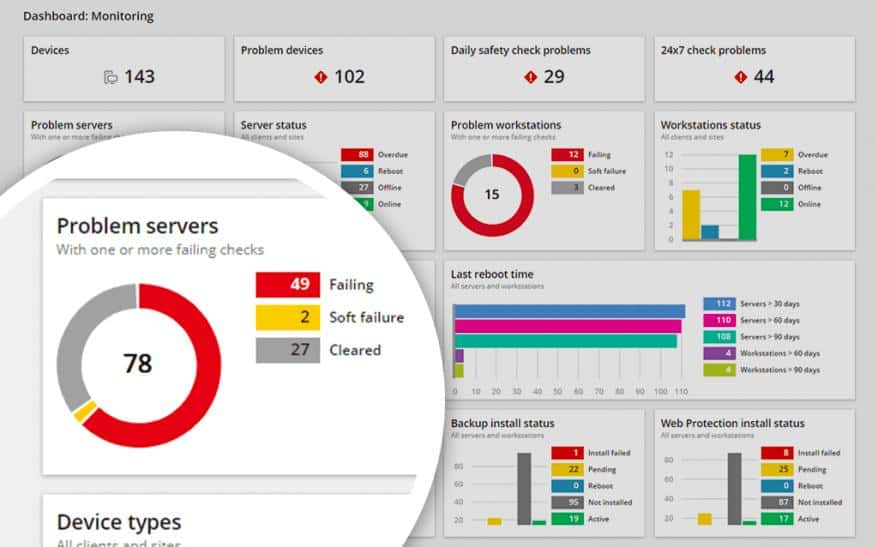
N-able N-sight is a SaaS remote monitoring and management software package that supports the management of all types of IT resources.
N-able N-sight’s Key Features:
- SaaS Model: Offers scalability and easy access via the cloud.
- Asset Management: Efficiently manages IT assets with automatic discovery.
- Task Automation: Streamlines routine maintenance and incident response.
- Data Security Features: Tracks sensitive data for compliance purposes.
Unique Business Proposition
N-able N-sight is an integrated RMM solution with remote access, patch management, and help desk ticketing, all in one platform. Its lightweight design and cloud-based deployment make it ideal for IT teams that need quick setup and efficient management without complex infrastructure.
Feature-in-Focus: Proactive Monitoring
N-sight provides real-time visibility into system health to detect and resolve issues before they impact business operations. Automated alerts and predictive insights also reduce downtime and improve overall system reliability.
Why do we recommend it?
N-able N-sight is another RMM package and it also provides a ticketing system, which makes it a very close match to Atera. The system includes automated monitoring utilities for networks, servers, and applications and it also provides asset management functions, such as equipment inventory creation and patching for endpoints.
The system monitors networks, servers, endpoints, mobile devices, and applications and it includes extensive systems management facilities. The systems management functions in the software service include task automation for regular maintenance jobs and for problem resolution and incident response. The system also includes a network discovery feature that takes care of inventory documentation and it is able to track down PII and track access to it for data security standards requirements.
Being a SaaS system, this service includes all of the supporting resources needed to run the RMM. This means that the company using this RMM doesn’t need to provide server space for file storage or processing power to run the monitoring and management software.
The dashboard for the service is hosted on N-able servers and it can be accessed through any standard web browser or a special mobile app. The systems being monitored and managed can be located anywhere, as long as they are connected to the internet. The management functions also give controls over cloud-based resources.
Who is it recommended for?
N-able N-sight is designed for use by IT departments and smaller managed service providers. N-able provides N-central RMM for large MSPs. This package aims to provide a service efficiency of 100 endpoints per technician. That’s a great cost saver and the cloud-based provision of this tool brings costs down further.
Pros:
- Versatile Monitoring Dashboard: Suitable for MSPs and NOC teams of various sizes.
- Remote Administration: Offers a wide range of automated options for remote support.
Cons:
- Complexity: The platform’s breadth of features requires time to fully understand and utilize.
There are no setup fees for N-able N-sight and the service is charged for by subscription with no deposit required. N-able N-sight removes all of the upfront costs that other system management tools usually require. N-able N-sight is available for a 30-day free trial.
10. SolarWinds Systems Management Bundle
Best For: IT infrastructure monitoring and performance optimization
Relevant For: Organizations in industries requiring robust network and server management, such as finance, healthcare, and government
Price: Starts at $27.50 per application instance

SolarWinds Systems Management Bundle is a system monitoring bundle that includes four different tools: SolarWinds Server & Application Monitor, SolarWinds Virtualization Manager, SolarWinds Storage Resource Monitor, and SolarWinds Web Performance Monitor. These tools automatically discover infrastructure and applications throughout your network.
SolarWinds Systems Management Bundle’s Key Features:
- Comprehensive Monitoring Suite: Offers a full range of monitoring for servers, applications, and web performance.
- PerfStack Dashboard: Visualize performance data with graphs and charts for easy analysis.
- Orion Platform Integration: Seamlessly integrates with SolarWinds’ Orion platform for enhanced capabilities.
- AppStack View: Provides a holistic view of application and network health in one dashboard.
Unique Business Proposition
This bundle provides a unified platform for monitoring servers, applications, and networks. It delivers deep insights into system performance, automates troubleshooting, and helps IT teams proactively prevent outages and security vulnerabilities.
Feature-in-Focus: Unified Performance Monitoring
With real-time dashboards and intelligent alerts, SolarWinds offers a single-pane-of-glass view of IT health. The bundle integrates network performance monitoring, server diagnostics, and application tracking for seamless IT operations with minimal downtime.
Comparitech Support Score – 8.9
SolarWinds is a well-established company and a pioneer in the world of monitoring. With a strong employee base and good supporting materials, it also has a high customer satisfaction score. However, its employee job satisfaction is one of the lowest among competitors, and this means, you must watch out for drops in customer service quality.
Why do we recommend it?
SolarWinds provides a range of system management and monitoring packages that are all based on a common platform, called Orion. The company provides bundles of modules including the Systems Management Bundle. This group includes the Server Configuration Manager, the Server & Application Monitor, the Log Analyzer, and the Virtualization Manager.
Performance can be monitored through the PerfStack dashboard. The dashboard displays performance data as graphs and charts. There are also over 1,200 infrastructure monitoring templates to help you get up and running ASAP.
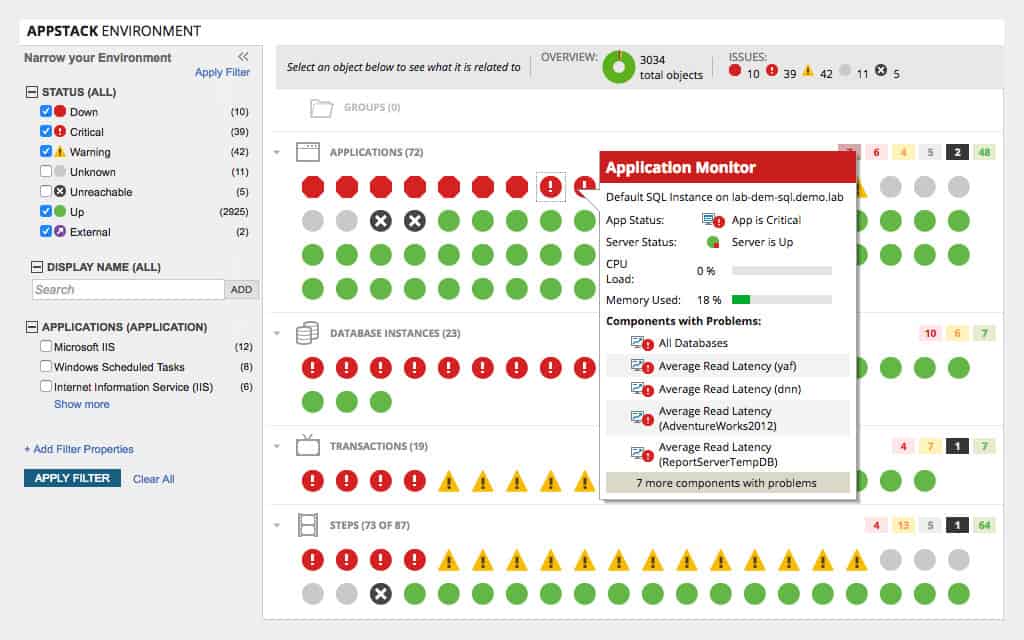
Overall, we particularly like the AppStack dashboard view that helps network admins visualize application instances, server instances, transactions, hosts, virtual datacenters, and more all in the one view.
Who is it recommended for?
This is a package that is suitable for use by large organizations. The software runs on Windows Server and SolarWinds actually has more system management modules that you can add on. These include the Network Configuration Manager, the IP Address Manager, the Database Performance Analyzer, and the Access Rights Manager.
Pros:
- Extensive Coverage: Monitors a wide range of systems including applications, networks, and infrastructure.
- Rapid Deployment: Over 1200 templates for quick setup and immediate insights.
- Customizable Alerts: Configurable notifications via SMS, email, or third-party apps for real-time updates.
- User-Centric Customization: Allows creation of personalized dashboards and reports for tailored monitoring.
Cons:
- Complexity for Non-IT Users: Designed primarily for IT professionals, challenging for non-technical users to navigate.
You can pick and choose which products you want to use in the bundle. SolarWinds Server & Application Monitor is the server monitoring solution and costs $2,995 (£2,316). SolarWinds Virtualisation Manager is the virtualization management component that costs $2,995 (£2,316).
SolarWinds Storage Resource Monitor is a storage management platform that starts at $2,995 (£2,316). SolarWinds Web Performance Monitor is a website monitoring tool that starts at $1,995 (£1,543). You can start a 30-day free trial.
11. Nagios XI
Best For: Enterprise-level IT infrastructure monitoring and proactive issue detection
Relevant For: Large enterprises, government agencies, and MSPs requiring advanced network, server, and application monitoring
Price: Depends on the number of nodes. 100 nodes start at $4,490 and go all the way to $25,990 for unlimited nodes
Nagios XI is an infrastructure management tool that provides a top-down perspective of network performance. Customizable dashboards give you complete control over how your network is monitored. There is a range of displays, including graphs and maps you can use to monitor network performance.
Nagio XI’s Key Features:
- Extensive Customization: Offers a customizable dashboard for tailored monitoring.
- Automated Capacity Planning: Assists in resource allocation and planning.
- Robust API: Facilitates integration with custom applications.
Unique Business Proposition
Nagios XI offers deep visibility into IT environments. It provides proactive identification and resolution of performance bottlenecks for IT systems. With extensive customization options and a robust alerting system, it optimizes infrastructure health.
Feature-in-Focus: Customizable Dashboards and Alerts
This systems management tool provides highly configurable dashboards that give IT teams a real-time view of network health, server performance, and application availability. Its powerful alerting system ensures that critical issues are addressed before they impact operations.
Why do we recommend it?
Nagios XI is a system monitoring tool for networks, servers, services, middleware, cloud platforms, and applications. An autodiscovery feature in the package records all devices on your network and creates a topology map. The tool also compiles a network device inventory and updates this with constant checks.
Features like automated capacity planning graphs keep you aware of the status of your current systems. Scheduling capacity planning reports help you to make sure that your usage requirements don’t exhaust your resources and put you out of action.
The extensibility of Nagios XI makes it a top-notch product. There are APIs for integrating with external applications and a range of add-ons developed by the community on the Nagios Exchange. The plugins on Nagios Exchange allow you to further customize your monitoring experience.
Who is it recommended for?
Nagios XI installs on Linux but you can also run it over VMware or Hyper-V if you only have servers running Windows. The package is quite expensive and small businesses with tight budgets should look at the free version, Nagios Core. Explore the free plug-in library to extend functionality.
Pros:
- Open-Source Flexibility: Provides transparency and customization through open-source architecture.
- Diverse Alerting Options: Supports a range of notifications including SMS and email.
Cons:
- Technical Setup: Installation and configuration can be complex and demanding.
- Integration Limitations: Could benefit from more integrations with ticketing systems.
There are two versions of Nagios XI available to purchase; Standard Edition and Enterprise Edition. The Standard Edition starts at $1,995 (£1,512) with features including configuration wizards and reports. The Enterprise Edition starts at $3,495 (£2,703) and includes features like capacity planning reports, audit logging, and more. You can download the free trial.
12. Zabbix
Best For: Open-source IT monitoring with extensive customization and scalability
Relevant For: Large organizations, data centers, telecom companies, and cloud service providers looking for a cost-effective yet powerful monitoring solution
Price: Free
Zabbix is an open-source system monitoring solution. Zabbix blends server, cloud, application, and network monitoring into one platform. You can monitor network health, bandwidth usage, and configuration changes. The visualization capabilities are vast with everything from charts and graphs to cluster displays (logical maps of clusters).
Zabbix’s Key Features:
- Comprehensive IT Asset Management: Tracks a wide range of metrics for device health.
- Flexible Alerting: Supports various notification methods, including third-party integrations.
- Adaptable with Add-ons: Enhances functionality with free, community-provided add-ons.
Unique Business Proposition
Zabbix provides full-stack monitoring for networks, servers, applications, and cloud environments without licensing fees. It supports advanced automation, predictive analytics, and flexible integrations, making it ideal for businesses seeking a customizable and scalable monitoring solution
Feature-in-Focus: Predictive Monitoring & Trend Analysis
This platform leverages historical data and machine learning to detect anomalies, predict failures, and optimize performance. Its trend analysis capabilities help IT teams proactively prevent outages and ensure system reliability.
Why do we recommend it?
Zabbix is a respectable, free system monitoring service that competes well with paid tools, such as Nagios XI. This package runs on-premises and you can customize and expands it through a library of templates. This system will discover and map your network, creating an equipment inventory.
Templates provide you with out-of-the-box configurations, graphs and discovery rules for a range of vendors. There are templates available for Cisco, Dell, Intel, Juniper Networks, Huawei, Netgear, Hewlett Packard Enterprise, and more. There is also a range of additional templates and modules that can be found on the community site.
Who is it recommended for?
Zabbix is written for Linux and it has agents that will monitor devices running Windows and macOS across the network from its Linux host. The package can also be run over Docker, virtualizations, or hosted on cloud platforms. The free tool is attractive for small businesses but it is also used by large organizations.
Pros:
- Free and Open-Source: Offers a no-cost solution with premium features.
- Wide Monitoring Range: Tracks connectivity, power consumption, temperature, and more.
Cons:
- Community-Dependent Support: Relies on the community for support and bug fixes, which can be unpredictable.
- Linux-Only Deployment: Limits usability to Linux environments, excluding other platforms.
Zabbix is recommended for enterprises that want a low-cost tool with premium functionality. Zabbix is available for Red Hat Enterprise Linux, CentOS, Oracle, Linux, Ubuntu, Debian, SUSE Linux Enterprise Server, and Raspbian. You can download the software for free.
13. OP5 Monitor
Best For: Scalable IT monitoring with a strong focus on network infrastructure
Relevant For: Organizations, telecom providers, and MSPs that require high-performance monitoring across distributed IT environments
Price: Negotiated pricing
OP5 Monitor is an open-source network and SNMP monitoring tool. OP5 Monitor has an auto-discovery feature that automatically discovers devices connected to the network. Once the program discovers your SNMP-enabled devices, you can start to monitor performance and availability. There is out-of-the-box support for a range of vendors to reduce the level of configuration needed.
OP5 Monitor’s Key Features:
- Automated Inventory Management: Keeps track of assets efficiently.
- Performance Monitoring: Offers insights into network and server performance.
- SLA Templates: Facilitates service level agreement compliance.
Unique Business Proposition
OP5 Monitor is an enterprise-grade network, server, and application monitoring tool with a centralized view of IT infrastructure. Its flexibility, scalability, and support for hybrid IT environments make it a strong alternative to traditional monitoring tools.
Feature-in-Focus: Scalable Multi-Site Monitoring
OP5 Monitor excels in tracking IT assets across multiple locations. With distributed monitoring, businesses gain real-time insights into system health, network performance, and service availability for uninterrupted operations.
Why do we recommend it?
ITRS OP5 Monitor tracks the performance of IT assets in hybrid environments. The tool includes a discovery routine that registers all assets in an inventory. This process repeats so that the inventory is kept constantly up to date. This is a network monitor but it will also track the performance of servers and cloud platforms.
However, you can configure your own alert rules and notifications and configure notifications for networks, databases, and OS resources. For example, if key resources are running low on disk space or CPU load is unusually high then the software will send you a notification.
Reports allow you to further analyze your network activity. There is a range of reports including alert summary, alert history reports, availability reports, SLA reports, and more. Reports can be saved as PDF or CSV files.
Who is it recommended for?
OP5 Monitor runs on Linux. However, its capabilities for monitoring systems are not restricted to the site on which it is hosted. ITRS stresses the suitability of this tool for monitoring multiple sites and cloud platforms. This system probably won’t appeal to small businesses but it is suitable for mid-sized and large enterprises.
Pros:
- User-Friendly Interface: Simplifies monitoring for team environments.
- Onboarding Support: Provides assistance for new users, easing the adoption process.
Cons:
- Community-Dependent Support: Relies on community for bug fixes and support.
- Limited Compliance Reporting: Could benefit from more options in compliance-based reporting.
You can request pricing from the company directly (the price will depend on the number of devices that you are looking to support). Download the 30-day free trial.
14. KACE Systems Management Appliance
Best For: Endpoint management and IT asset tracking for mid-sized to large organizations.
Relevant For: Large organizations, educational institutions, and government agencies that need centralized control over IT assets and automated endpoint management.
Price: Starts at $11/month
KACE Systems Management Appliance is a systems management platform that allows you to monitor computers, laptops, servers, tablets, printers, storage, and more. The software helps you to manage resource allocation, manage your inventory of IT assets, and perform software license management.
KACE Systems Management Applicance’s Key Features:
- Software License Management: Keeps track of software licenses and compliance.
- Vulnerability Scanning: Identifies security risks for proactive management.
- Comprehensive IT Management: Manages a wide range of IT assets effectively.
Unique Business Proposition
KACE Systems simplifies IT asset management by automating software deployment, patching, and compliance reporting. It reduces administrative overhead by offering a single, intuitive platform for managing devices across diverse environments.
Feature-in-Focus: Automated Patch Management
With KACE, IT teams can schedule and deploy patches across multiple operating systems and applications to ensure endpoint security. The system provides real-time visibility into patch compliance, reducing risks associated with outdated software.
Why do we recommend it?
KACE Systems Management Appliance provides asset management with a particularly strong capability for software management. This extends to deployment automation and patching. The software deployment system lets you create software profiles for job roles or device types and then install them in bulk through a package. You can add on mobile device management.
The platform doesn’t just give you more visibility but also allows you to perform tasks like vulnerability scans and patching. Checking for vulnerabilities and remotely patching devices saves you time and reduces vulnerabilities that could potentially be exploited by an attacker. There are also alerts that notify you about performance events.
Who is it recommended for?
The KACE system is a good solution for mid-sized businesses. It is part of a large series of tools under the KACE brand that can all be integrated together. These include a Service Desk system for managing IT department tasks. The software for all KACE units runs on VMware or Hyper-V.
Pros:
- Integrated Asset and License Management: Streamlines software and device management.
- Security-Focused Features: Enhances IT security posture with vulnerability scanning and patching.
Cons:
- Not Ideal for MSPs: Better suited for in-house IT rather than managed service providers.
- Pricing Transparency: Requires direct contact with the sales team for pricing information.
KACE Systems Management Appliance will work well with enterprises that want to manage IT assets from a single location. However, you will have to contact the sales team to view the pricing information. You can download the free trial.
15. ConnectWise Automate
Best For: IT service providers and MSPs looking for an all-in-one RMM platform
Relevant For: MSPs, IT consulting firms, and mid-to-large enterprises that require a unified IT management solution for monitoring, automation, and service delivery
Price: Negotiated pricing
ConnectWise Automate is a systems management platform that combines infrastructure monitoring with automation capabilities. ConnectWise Automate automatically discovers devices so they can be monitored. There are remote control sessions so you can automatically record remote sessions to monitor user activity and comply with auditing requirements.
ConnectWise Automate’s Key Features:
- Automated Patching: Keeps systems up-to-date with minimal manual intervention.
- Performance Monitoring: Tracks system performance for optimal operation.
- Remote Management: Facilitates distant administration of IT assets.
Unique Business Proposition
ConnectWise offers a robust, integrated platform that combines RMM, PSA, and security tools. It enables IT teams to proactively manage endpoints, automate routine tasks, and improve service efficiency with a centralized dashboard.
Feature-in-Focus: Proactive Monitoring and Automation
It provides advanced remote monitoring features, enabling IT teams to detect and resolve issues before they impact end users. With automation capabilities, technicians can set up self-healing scripts, scheduled maintenance, and patching workflows, reducing manual intervention and downtime.
Why do we recommend it?
ConnectWise Automate is a remote monitoring and management package that includes task automation features to optimize the capabilities of technical staff. The system management features of this package include system discovery and asset inventory creation, remote access for endpoint maintenance, and patch management.
ConnectWise Automate has an alerts system so that you receive notifications about performance issues and security events. Notifications ensure that you never miss any vulnerabilities or other issues that could affect your network.
Systems patching is one of the most useful features included with ConnectWise Automate. With the patching feature, you can patch Windows devices remotely. Patching devices remotely make your IT management process more efficient.
Who is it recommended for?
This package is suitable for use by in-house IT departments. This is a cloud-based system and you manage it through a Web-based console. This interface will guide you through the installation of an agent onto a host on your site. The tool is suitable for use by mid-sized organizations.
Pros:
- All-in-One Dashboard: Integrates remote management, inventory, and reporting in one place.
- Customizable Interface: Allows creation of tailored views for individuals or teams.
Cons:
- Complex User Interface: Some areas, especially in reporting and management, can be confusing.
- Limited Trial Period: A longer trial would be beneficial to fully explore the platform’s features.
ConnectWise Automate is a platform designed for environments where administrators seek to automate network monitoring tasks and reduce manual administration. To view the price for ConnectWise Automate you will have to contact the company directly. You can download the free trial.
Choosing systems management tools and software
Choosing the right systems management tool or software can be the difference between a normal productive day at the office or going back to the dark ages! All of the tools listed in this article are suitable for system management in modern IT environments.
If you’re looking for complete systems management packages, then the SolarWinds System Management Bundle or Paessler PRTG Network Monitor are great starting points. The latter would also work well in environments that desire a freeware product. If you want to go the open-source route then Zabbix is another excellent unified monitoring solution.
Recommended reading:
Our Methodology for Choosing a Systems Management Tool
We understand how the right systems management tool can make your IT operations smoother, reduce headaches, and deliver real value. This is why our team of experts and researchers came up with a methodology that focuses on what matters for your IT teams.
Here’s how we narrowed down our top picks.
1. Real-World Usability
A tool can have all the features in the world, but if it’s clunky and frustrating to use, it’s not going to help your team. We looked at how intuitive each tool is, how quickly IT teams can get up to speed, and whether it simplifies daily tasks rather than adding more complexity.
2. Automation That Actually Saves Time
Manual work drains resources, so automation is key. We prioritized tools that automate routine tasks like patching, configuration management, and monitoring, without requiring a PhD in scripting. The goal? A tool that makes IT operations hands-free, not harder.
3. Performance and Scalability
Your IT environment won’t look the same in five years, so we focused on tools that can grow with your organization. Whether you’re managing a handful of servers or an entire hybrid cloud infrastructure, the best tools handle scaling without slowing down.
4. Security and Compliance Built-In
The best tools must protect systems from emerging threats. We looked for features like real-time vulnerability detection, patch management, compliance tracking, and built-in security controls to keep threats at bay.
5. Vendor Support
When things go wrong (and they will), good support makes all the difference. We evaluated whether vendors provide fast, knowledgeable support, as well as documentation, user communities, and training resources to help IT teams get the most out of their investment.
6. ROI and Cost-Effectiveness
IT budgets aren’t unlimited, so cost matters. We compared pricing structures, licensing models, and the overall return on investment. Some tools justify a higher price tag with better automation and efficiency, while others offer solid features at a lower cost.
At the end of the day, we didn’t just pick tools based on specs. Rather, we focused on what will make life easier for your IT teams. A great systems management tool should free up time, improve security, and help businesses run more efficiently. That’s what we prioritized in our research.
Broader B2B Software Selection Methodology
A vendor’s reliability, transparency, and long-term support are just as critical as the tool’s functionality. That’s why we go beyond basic feature comparisons and assess the vendor’s overall trustworthiness and commitment to its customers.
Our evaluation considers the following factors.
- Tool’s cost in relation to the value it provides in solving business challenges
- Software’s functionality and ability to scale with growing business needs
- Customer feedback and real-world user experiences
- Vendor’s dedication to continuous product improvements
- Transparency in pricing, features, and any known limitations
While we may not cover each of these factors in every review, we make it a point to highlight them when they stand out—whether positively or as a potential red flag for buyers.
Vendor Support & Reliability Assessment
To ensure a vendor provides strong product support and ongoing development, we use a structured approach to evaluate their capabilities. Our assessment applies across different software categories since quality customer and product support are universally important.
We focus on five key indicators of a vendor’s ability to deliver consistent support and long-term product development. They are:
- Total number of employees
- Revenue and funding stability
- Employee job satisfaction and retention
- Presence of a dedicated customer success team
- Availability and quality of self-service documentation
Each of these factors is scored on a 0-10 scale, with weighted importance based on how much they impact the buyer’s overall experience.
For a deeper look at how we assess vendor support and why it matters in software selection, check out our detailed methodology breakdown.
Why Trust Us?
Our team has spent years analyzing enterprise IT solutions, with hands-on experience in systems management, security, and compliance. We understand the challenges IT teams face and what it takes for a tool to deliver real value.
What makes our approach different? The following factors.
- Expert Insights: Our evaluations are built on deep research, practical experience, and industry best practices.
- Real-World Testing: Whenever possible, we test tools in real IT environments to assess their true performance.
- Ongoing Updates: Technology evolves fast, and so do our reviews. We continuously update our assessments to reflect software improvements, vendor changes, and industry shifts.
With our thorough analysis and clear methodology, you can confidently select the best systems management tool for your organization.



